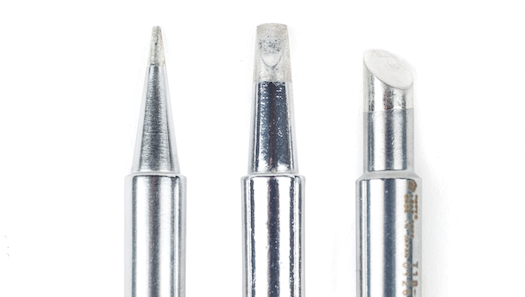
There are hundreds of different soldering iron tip shapes and sizes used in everything from jewelry making to plumbing to even stained glass.
We’ll focus on the 3 most common for electronics work: chisel, conical, and bevel tips.
BEVEL TIP (AKA HOOF TIP)
While not as common as the chisel and conical tips, the bevel tip can be used for solder jobs that require pre-loading the iron with solder. The large flat surface can hold more solder than most other tips, and it’s helpful when soldering small-gauge wires together or dragging solder across surface-mount chips to solder multiple pins at once.
CHISEL TIP
With its broad tip, the chisel tip helps to evenly deliver heat to component leads and pads. This tip is great for soldering wires, through-hole components, large surface-mount components, and for desoldering as well.
 CONICAL TIP
CONICAL TIP
Conical tips are usually used for precision electronics work, though they’re also often used for general soldering. The pointed tip helps deliver heat to small areas, such as tiny surface-mount components.
NOTE: Tips for one brand of soldering iron are often not compatible with others, so be sure to verify that tips are designed for your soldering iron before buying them.
SPECIALIZED TIPS: There are endless varieties of specialized tips designed for specific jobs — even if they aren’t soldering related. For example, this spade tip is used to scrape UV glue off of LCD glass.







 CONICAL TIP
CONICAL TIP




